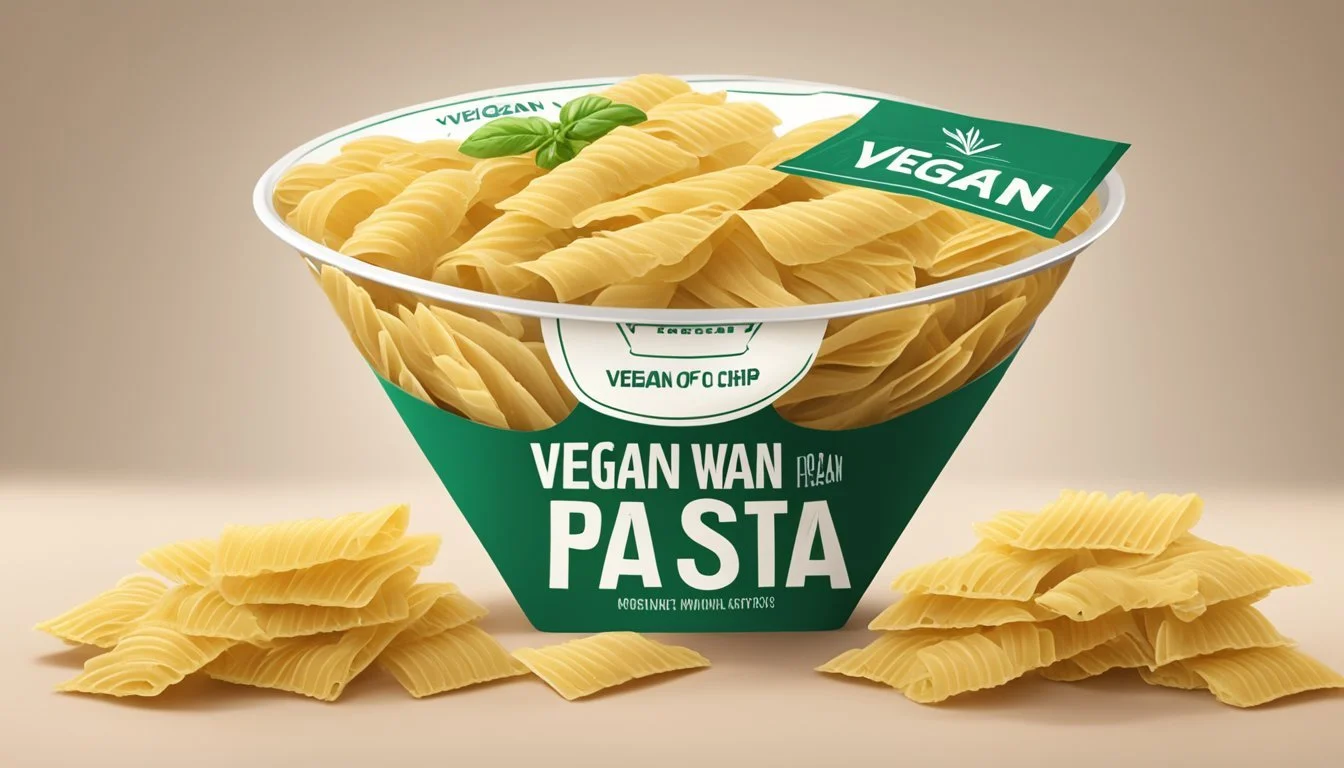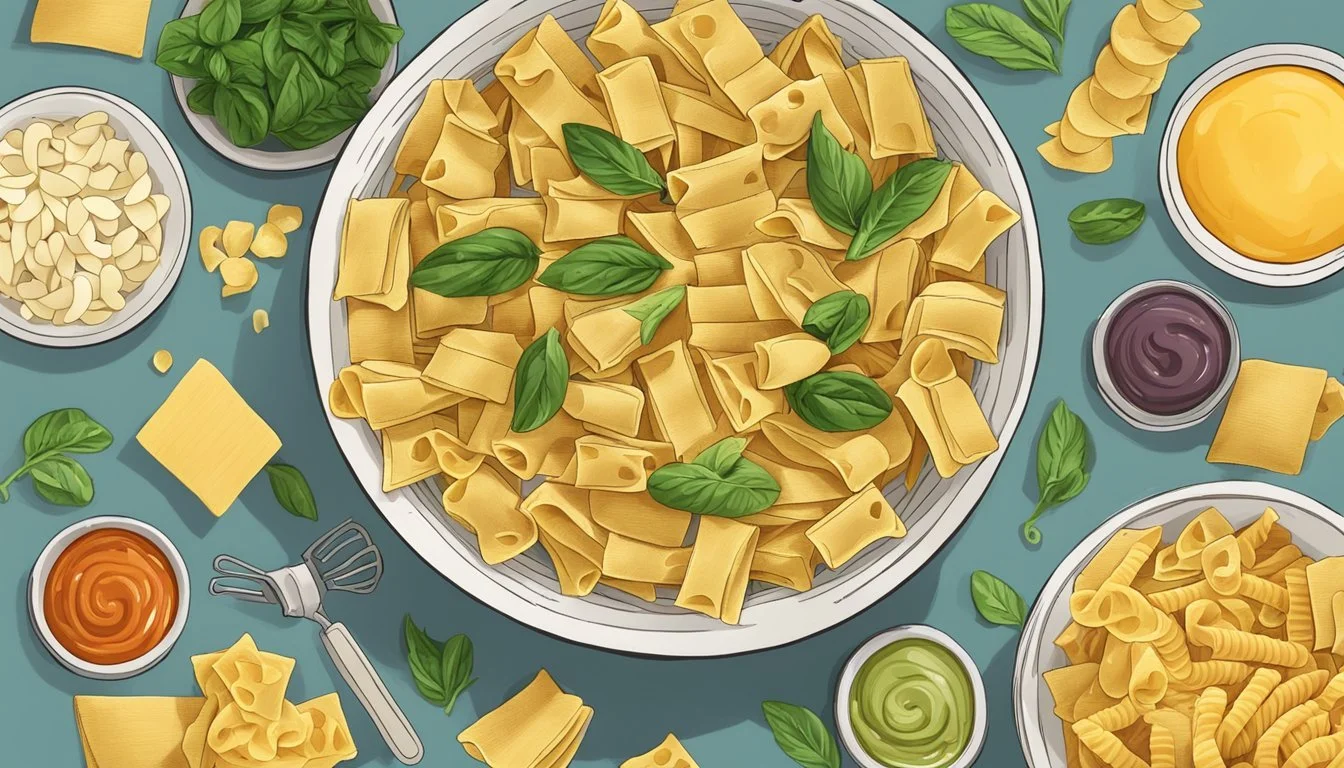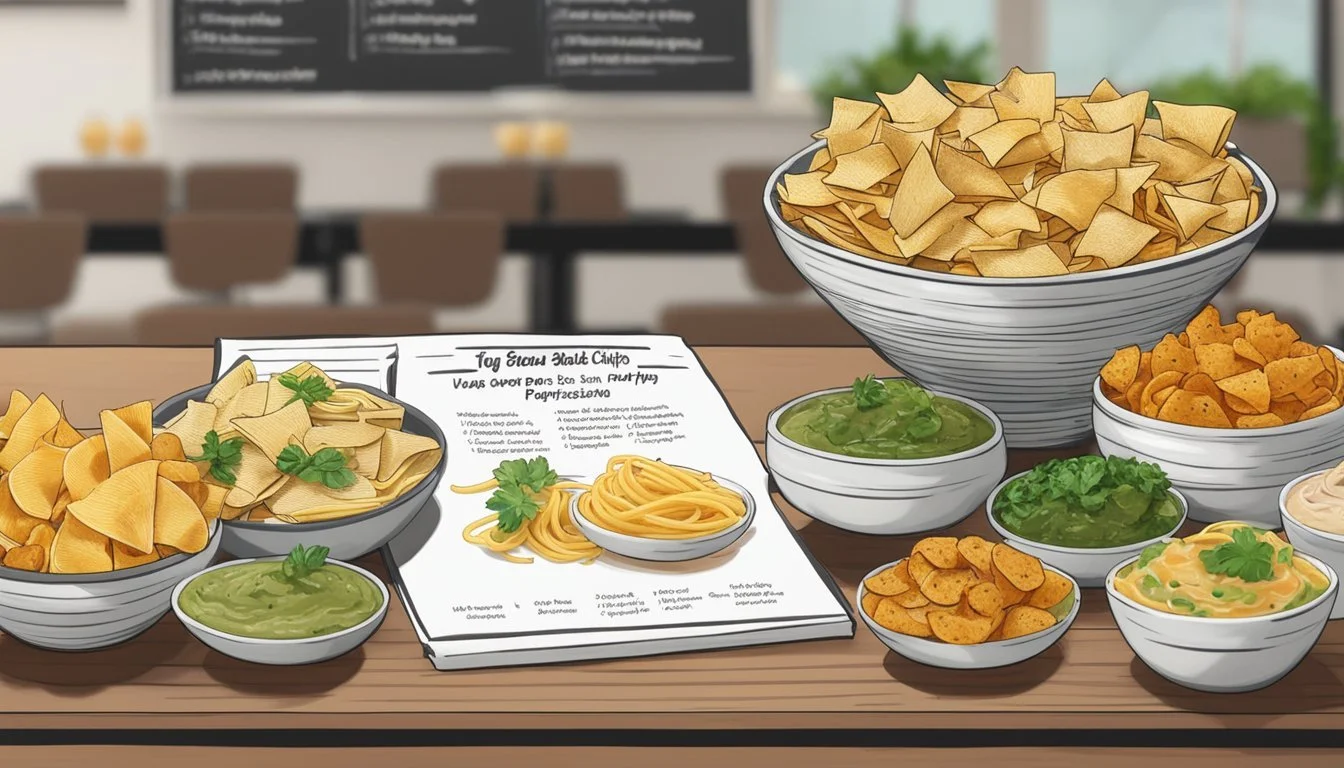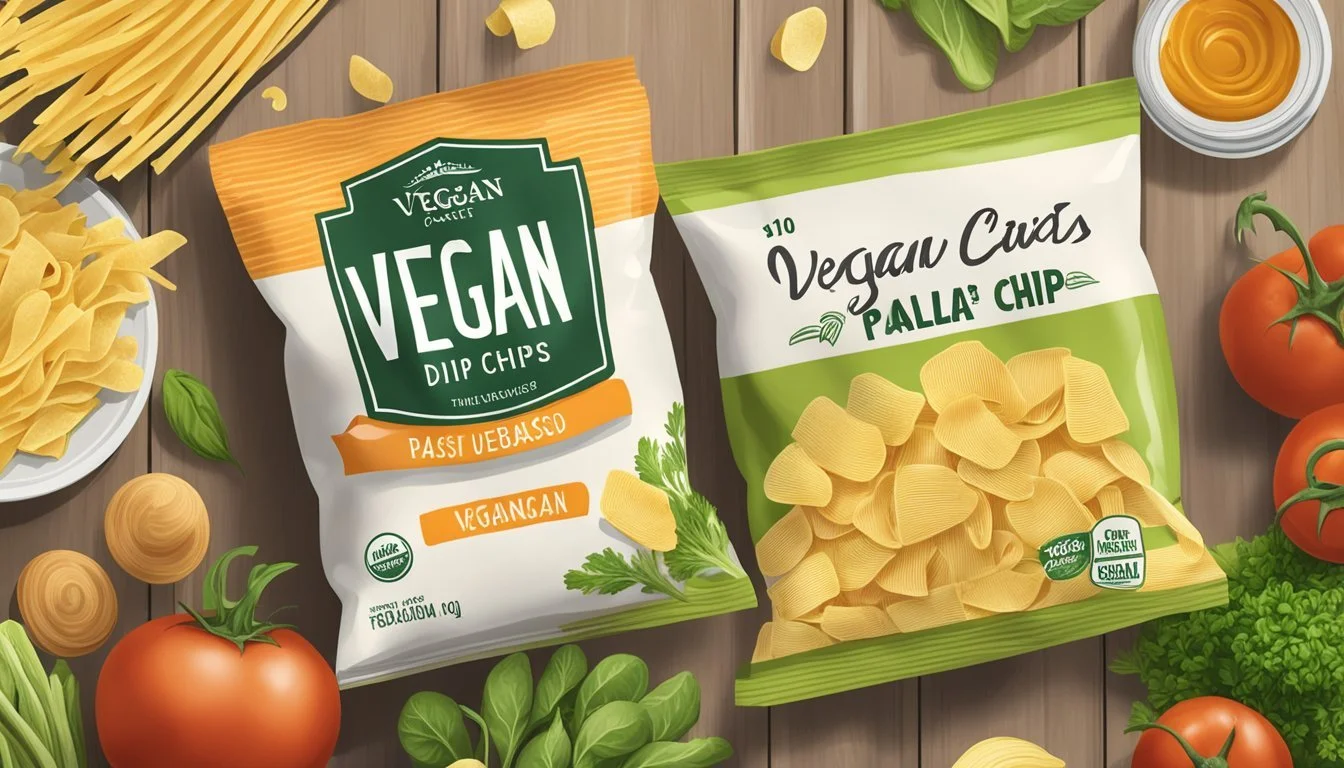Are Pasta Chips Vegan?
Understanding Plant-Based Snacking Options
Pasta (What wine goes well with pasta?) chips, a recent viral snack trend, have taken the culinary world by storm with their satisfying crunch and versatility in flavor. Essentially, they are thinly sliced pasta pieces that are seasoned and then baked or fried until they reach a perfect crispness. Given the simplicity of their primary ingredient—pasta—the question arises whether pasta chips can fit into a vegan diet.
The vegan lifestyle excludes all animal products, which includes dairy and eggs, common ingredients in some pasta varieties. The majority of pasta sold in grocery stores, however, is naturally vegan, made from wheat and water. When making vegan pasta chips, it's crucial to choose pasta that does not contain eggs or any other animal-derived additives.
Seasoning and preparation method play pivotal roles in maintaining the vegan quality of pasta chips. Vegan-friendly seasonings range from simple salt and pepper to nutritional yeast, which can impart a cheesy flavor without the dairy. Olive oil or other plant-based oils can be used to help these seasonings adhere to the pasta before it goes into the air fryer or oven. With careful ingredient selection, pasta chips can be a delightful vegan snack that aligns with plant-based dietary preferences.
Understanding Pasta Chips
Pasta chips have emerged as a trendy snack, with their roots in viral social media trends and a simple yet inventive culinary approach. They represent a novel way to enjoy the classic pasta in a crispy, snackable form.
Origins and Popularity
The pasta chip phenomenon can be traced back to TikTok, where inventive food trends often gain rapid popularity. As users sought creative and new ways to enjoy familiar foods, transforming pasta into chips became a viral sensation. The appeal lies in the snack's novelty and the ease of preparing it with an air fryer, making pasta chips a fast favorite among those looking for a unique and tasty treat.
Fundamentals of Pasta Chips
Fundamental to making pasta chips is the transformation of cooked pasta into a crispy, chip-like snack. This is typically achieved by:
Cooking pasta: First, one must cook the pasta until it's al dente, which ensures it retains some firmness and doesn't become too soft when air-fried.
Seasoning: After draining, the pasta is coated with oil and a mixture of various seasonings to add flavor. These can include salt, garlic powder, nutritional yeast, or more specialized flavors like vegan Parmesan.
Air frying: Using an air fryer, the seasoned pasta is cooked at a high temperature until it achieves a golden brown, crispy texture. The time can vary, usually ranging from 8 to 20 minutes depending on the air fryer's model and the type of pasta.
Pasta Types Suitable for Chips
For the best results, certain types of pasta are more suitable for making chips due to their shape and surface area. Ideal options include:
Bowtie (farfalle): This shape provides a good surface for crisping and an appealing look.
Penne: Cylinder shapes that catch seasonings well and crisp nicely.
Rotini: The spirals offer an interesting texture and help to hold the seasoning.
The key is to select pasta that can handle a crisp texture without breaking apart, thus maintaining the chip-like integrity.
Vegan Diet Essentials
Exploring a vegan diet requires understanding its definition and familiarizing oneself with vegan-friendly ingredients that are both nutritious and versatile.
Definition of Vegan
A vegan diet excludes all products of animal origin. Individuals following this lifestyle opt for foods derived purely from plant sources, ensuring that they do not consume meat, dairy, eggs, or any other animal by-products.
Common Vegan Ingredients
Plant Proteins: Legumes, such as chickpeas and lentils, are staples in a vegan diet, offering significant amounts of protein, fiber, and essential nutrients.
Whole Grains: Whole grain, gluten-free pasta provides a hearty base for meals, catering to those with gluten sensitivities and delivering complex carbohydrates and fiber.
Nutritional Additions: Nutritional yeast is a popular ingredient, adding a cheese-like flavor while being a source of B-vitamins and protein.
Vegan Cheese: Vegan parmesan, made from ingredients like cashews and nutritional yeast, is widely used to garnish and enhance the flavor of vegan dishes.
Pasta Chips Ingredients and Substitutions
Creating vegan pasta chips requires selecting the right ingredients and understanding possible substitutions to align with a plant-based diet. This section will guide you through the various options for pasta, oil, seasonings, and cheese replacements.
Choosing the Right Pasta
For the pasta base, one has a variety of options ranging from traditional wheat-based pastas to gluten-free alternatives. Whole wheat pasta adds a robust flavor and texture, while gluten-free versions like chickpea, brown rice, or pea pasta provide alternatives for those with dietary restrictions without compromising on the desired crispy result.
Wheat Pasta: Whole wheat spaghetti, fettuccine
Gluten-Free: Chickpea rotini, brown rice fusilli, pea penne
Vegan-Friendly Oils
Olive oil is a popular choice for making pasta chips, cherished for its taste and health benefits. However, for a different flavor profile or due to personal preference, one can opt for other plant-based oils such as avocado oil or coconut oil. These oils should be used in moderation to lightly coat the pasta before air frying or baking.
Preferred Oil: Extra virgin olive oil
Alternatives: Avocado oil, coconut oil
Seasonings and Flavors
A blend of spices and seasonings is essential for achieving the perfect flavor. Commonly used Italian seasoning and garlic powder provide a classic taste, but one can experiment with various herbs and spices such as paprika, onion powder, or nutritional yeast for a cheesy, umami flavor.
Classic: Garlic powder, Italian seasoning
Creative: Paprika, onion powder, nutritional yeast (for a cheesy flavor)
Vegan Cheese Alternatives
While traditional pasta chips may include cheese such as parmesan, vegans can substitute with nutritional yeast or store-bought vegan parmesan alternatives made from nuts and seeds. These products are specifically designed to replicate the flavor and texture of cheese, making them a suitable alternative for vegan pasta chips.
Direct Substitute: Nutritional yeast
Store-bought Options: Vegan parmesan (cashews, almonds, sunflower seeds, or pumpkin seeds-based)
Creating Vegan Pasta Chips
Pasta chips, a recent snacking trend, can be easily adapted for a vegan diet. By selecting the right pasta and seasonings, one can create a delicious and cruelty-free snack.
Preparation Techniques
The cook should start by choosing a vegan pasta, ensuring it is free of eggs and dairy. Tip: Most regular grocery store pasta fits this criterion, but it's essential to check the labels. The pasta needs to be cooked al dente according to the package instructions. Once cooked, it's drained then tossed with a blend of olive oil and a selection of vegan-friendly spices such as garlic powder, paprika, and nutritional yeast for a cheesy flavor.
Air Frying vs Baking
To achieve a crispy texture, there are two main techniques: air frying and baking.
Air frying: It typically requires a shorter cook time, around 8-12 minutes, and the pasta chips often emerge evenly cooked and golden brown. A preheat to 375°F (190°C) before adding the pasta is recommended.
Baking: For those without an air fryer, baking in an oven preheated to 400°F (200°C) for about 15-20 minutes, while tossing halfway through, can yield similar crispy results.
Cooking Instructions
Below are step-by-step instructions tailored for both air frying and conventional baking methods.
Air Fryer Method:
Prep Time: 10 minutes
Cook Time: 8-12 minutes
Instructions:
Preheat the air fryer to 375°F.
Place half of the seasoned pasta in the basket to avoid overcrowding.
Cook, shaking the basket occasionally for even crisping.
Oven Baked Method:
Prep Time: 10 minutes
Cook Time: 15-20 minutes
Instructions:
Preheat the oven to 400°F.
Spread the seasoned pasta in a single layer on a baking sheet lined with parchment paper.
Bake, tossing the pasta halfway through to ensure even cooking.
Using these techniques, the chef can produce a plant-based, delicious snack that aligns with vegan dietary preferences.
Serving and Pairing
When it comes to enjoying vegan pasta chips, the choice of dips and accompaniments can enhance the snacking experience. This section outlines how to pair pasta chips with various dips and sauces, incorporate them into snack platters, and serve them as a unique side dish.
Dips and Sauces
Vegan pasta chips find their perfect match in a range of dips and sauces. Marinara sauce serves as a classic option, bringing a tangy and robust tomato flavor that complements the crispy chips. For those seeking a creamy texture, a vegan ranch dressing made with plant-based ingredients offers a cooling and herbaceous dip. Hummus, with its smooth consistency and savory taste, can also be an excellent dip that pairs well with the seasonings of the pasta chips.
Dip Ideas:
Marinara Sauce: Tangy and classic
Vegan Ranch: Creamy with herbs
Hummus: Savory and smooth
Snack Ideas
Pasta chips are versatile and can be central to a variety of snack options. They work well on an appetizer platter, surrounded by cut vegetables, vegan cheeses, and nuts. Serving them at a gathering or for a movie night can draw interest and excitement, especially when presented with a selection of dipping sauces.
Appetizer Platter Components:
Vegan Pasta Chips
Cut Vegetables: Carrots, celery, bell peppers
Vegan Cheeses
Nuts: Almonds, walnuts, cashews
Serving as a Side Dish
Aside from being a standalone snack, vegan pasta chips can be an innovative side dish. They add a delightful crunch when served alongside a main course such as vegan wraps or sandwiches. Their unique texture and flavor can elevate a simple meal to a more sophisticated culinary experience.
Side Dish Pairing Ideas:
Vegan Wraps
Sandwiches: Grilled vegetable, chickpea salad sandwiches
Nutritional Considerations
When assessing pasta chips in terms of nutrition, especially for vegans, one should consider both the preparation methods that affect their healthfulness and the balance of macronutrients within the snack.
Comparing Healthier Options
Pasta chips are often praised for their crispy and crunchy texture, attributes that may be achieved by frying or baking. For a healthier vegan version, individuals may opt for air frying or baking pasta chips with less oil. In certain recipes, nutritional yeast can be added for a cheese-like flavor and is a source of B-vitamins and protein.
Oil-Free Variants: Air frying or baking pasta without oil can reduce calorie density and improve the snack's health profile.
Nutritional Yeast: An ingredient that offers not only a cheesy flavor but also provides additional protein and vitamins.
Understanding Macronutrients
Maintaining macronutrient balance is crucial for a healthy diet. Pasta chips can provide a source of carbohydrates, and depending on the recipe, it can also contribute protein and fats. For instance, some vegan ranch dips that accompany pasta chips might be made with cashews or soy, providing a source of protein and healthy fats.
Protein: Vegan ranch or sauces made with seeds or nuts can increase the protein content.
Fats: Healthy fats can be incorporated through the choice of oil, such as olive oil, used in seasoning the pasta.
Practical Tips and Tricks
In making pasta chips, one aims for ease, speed, and taste. The following tips and tricks are to ensure they get the most out of this snack, whether one is cooking a fresh batch, storing leftovers, or getting creative with flavors.
Cooking Shortcuts
For a quick snack, one can use leftover pasta as the base for pasta chips. There's no difference in outcome between fresh and leftover pasta. They should heat the air fryer to 375°F (190°C) and cook the pasta until it’s crispy and golden brown, usually taking about 8-10 minutes. Shaking the basket halfway through the cooking process ensures an even crisp.
Air Fryer Temperatures:
Preheating Time: 3-5 mins
Cooking Time: 8-10 mins (for leftover pasta)
Proper Storage
After the pasta chips have cooled, they should store them in an airtight container to maintain their crispiness. Excess moisture is the enemy of the crunchy texture, so ensuring the container is sealed properly is essential. Pasta chips can remain fresh for up to a week if stored correctly.
Storage Protocol:
Cool completely before storing
Use airtight containers
Keep in a cool, dry place
Experimenting with Flavors
They shouldn't be afraid to experiment with a variety of flavors. From classic Italian herbs to spicy cayenne, the flavor possibilities are endless. For instance, tossing the pasta in olive oil and garlic powder before air frying creates a simple yet delicious taste. Those interested in bold flavors might combine nutritional yeast and smoked paprika for a vegan take on cheese-flavored chips.
Flavor Combinations:
Italian: Olive oil, garlic powder, dried basil, and oregano
Spicy: Olive oil, cayenne pepper, garlic powder, and chili flakes
Cheesy Vegan: Nutritional yeast, smoked paprika, garlic powder, and turmeric
Using these practical tips and tricks, one will find that preparing vegan pasta chips is both an easy and satisfying way to produce a snack that’s not only quick to make but also delightful to the palate.
Answering Common Questions
In this section, we address common inquiries about pasta chips regarding their vegan status, gluten content, and the availability of oil-free options.
Are All Pasta Chips Vegan?
Not all pasta chips are vegan. While the basic ingredients of traditional pasta—flour, water, and sometimes eggs—are often used in making pasta chips, vegan consumers should look for brands that specifically state no animal products are used. Additionally, flavorings and additives may not be vegan.
Common non-vegan ingredients to watch out for:
Cheese or cheese flavorings
Butter or butter flavorings
Honey
Can Pasta Chips Be Gluten-Free?
Pasta chips can indeed be gluten-free. Gluten-Free Option pasta chips are made using alternative flours such as rice, corn, quinoa, or legume-based flours. Consumers should check the packaging for certification to ensure the absence of gluten.
Types of gluten-free flours used:
Rice flour
Corn flour
Quinoa flour
Are There Oil-Free Variations?
For consumers seeking Oil-Free Option pasta chips, it is less common but possible. They may be baked instead of fried and not contain any added oil. Reading ingredient labels is crucial as it will confirm whether oil is present or if the product indeed is oil-free.
Preparation methods for oil-free pasta chips:
Baked, not fried
Dehydration technique
Utilizing non-stick baking sheets without oil







